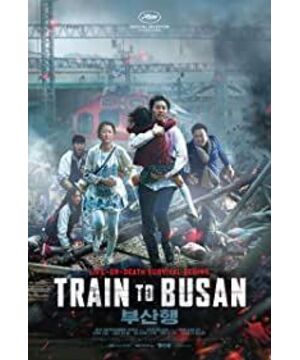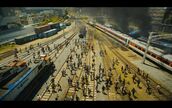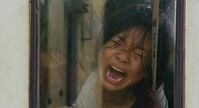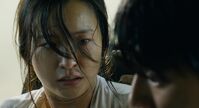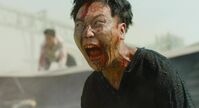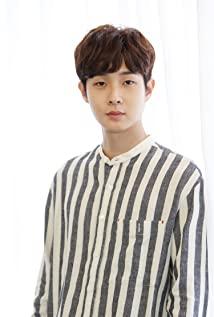It must be admitted that the national sentiment we show when facing South Korea is understandable - our feelings for a country are often swayed by many relationships, I am not a politician who is keen on this, and I do not intend to In this regard, a "grand theme" has been extended. My opinion is like the title of a Korean movie: a movie is a movie. "Cinema" can contain many levels of thinking, but it is still a thing called "movie" using moving light, shadow and sound. For any film, if one examines and speculates from a nationalist perspective, it will lose respect and objectivity for a film, or even a country's film industry. It's absurd and impersonal to do so: just as you can't kill The Birth of a Nation and Partisanship because of Griffith's racial views, or Riefenstahl's political views. Denying the value of Triumph of the Will is the same.
It's interesting that the land we live in has done many worse things to movies than the above examples, and we all think those times were not very good, but what we do today is different from what we did then. What kind of difference? On the other hand, the "censorship system" that has continued to this day is generally considered to have many drawbacks. Countless movie fans criticized loudly, and countless flag-bearers cheered. Whenever the "censorship system" is mentioned, the "opinion leaders" are filled with righteous indignation. After being criticized for this, we hold our heads high and accept the admiration and admiration of the "silent majority" like a national hero. However, for certain types of films or certain countries' films, many of us are invariably unanimous. The collectives create "blocking" and "censorship" simply because of their "personal emotions".
The growth and growth of such emotions are all natural, and we cannot escape the identity of "people" and blame them. But letting go of anger and stereotypes and respecting films and filmmakers is at least something that the fan community can and should do. It's not the most demanding, it's just the bare minimum homage to the movie. If you are a fan, then you should have the passion and dignity of being a fan.
The reason why I have to prepare for so long is because the next film, also from South Korea, also needs to be recommended to my friends. And this time, I hope that the friends who watch my analysis of this film can proudly maintain their enthusiasm and dignity. I would like to give a detailed answer to the various replies I have received. So this article may be very long, and I don't know how many words I will write, so let's just write it like this. Thanks in advance to those who can read it.
This year is a year of high-level Korean film explosion. From the beginning of the year to the present, the performance of Korean films in the awards season has been remarkable, and the domestic film box office has also repeatedly exploded. Among them, four South Korean films attracted the attention of major film festivals at almost the same time, and almost exploded the public accounts of various films and the circle of friends of movie fans, namely "The Cry", "Miss", "Tunnel" and "Train to Busan". ". Including "Ghost Town" released at the beginning of the year, the five works of different styles, themes and genres reflect the spirit of exploration, professionalism, artistic pursuit and production level of Korean filmmakers. Among these five works of typical significance, "Miss" is too stylized and is not feasible for reference; "Ghost Town" can reflect the creator's humanistic care and creative pursuit, but its subject matter is too sensitive. And the narrative mode of dual time and space and multi-protagonist structure has not been constructed perfectly; "The Cry" is more complicated, and it is not easy to analyze it as a genre film; "Tunnel" has a smaller pattern. Relatively speaking, "Train to Busan" has the possibility of imitation and the necessity of analysis and interpretation. This film also has the typical characteristics of Korean film genre, so it is also very suitable for interpretation. (Of course, "suitable" here is only a relative term. For various reasons, many domestic professional colleges seldom choose horror movies for analysis and explanation when choosing film analysis courses. This may also be a domestic horror movie. This is one of the reasons why films have always been difficult to make good works.) This is the first time I have used words to do this level of intensive film reading (because I am lazy, most of the previous intensive film readings were done in my mind when I watched the film repeatedly) , I don't know how "accurate" this kind of work I do, I may be born out of the characters, scenes and aspects of the film, and inevitably mixed with some Hollywood and domestic film content. Because in my opinion, simply interpreting a film is a very narrow way. If you look at a typical film from multiple perspectives in terms of history, culture, politics, and film itself, the analysis you get is often more usable value. In the process of intensive reading and analysis, I may also put forward my various opinions on many issues for the reference and exchange of interested friends. I also welcome your corrections.
Many well-known film critics and college teachers have their own understandings of the method of "film interpretation", and there are also many film explanations from colleagues on the Internet. And no matter what kind of film reading method, there must be no way around the "pulling film". Indeed, pulling a film is a necessary basic work. It is the most boring and complicated, and at the same time, it is the most effective and most solid training method for film analysis. There are different explanations for the steps of pulling the tab. The more popular version is the version of Professor Zhou Chuanji circulating on the Internet. However, there are many ways to pull tabs, and professional pull tabs should be refined to each shot. For ordinary movie fans, this kind of overly professional pull tab method is not necessary. If movie fans and friends want to exercise their film analysis ability by pulling films, my suggestion is: you don’t need to do detailed pulling work. When pulling films, you only need to divide the film into several scenes, and directly pull one scene or one at a time. A set of shots, and a whole movie in sequence, is enough for a certain depth of interpretation.
Therefore, the process of pulling the tab will not be emphasized here. What I want to focus on is the preparation before pulling the tab. This preparation includes a lot of things, and in one word is the understanding of the creative background of the film. This is very complicated and necessary work. This work can be long or short. Specifically, it can be divided into the following points:
1. Understanding of the main creators and their main works. This is easy to understand. Movies are works created by groups. When appreciating each literary and artistic work, we should maintain a certain degree of familiarity with the creators of this work, so as to understand the creators of these works. Personal style, genre preferences, etc. These preliminary understandings help us to make a deeper analysis of the film;
2. The main type, production scale, publicity form, etc. of the film. It needs to be specially explained that this point is not only for "genre films" with market requirements, but also applies to most films - this involves a problem of film concept, because in my opinion, the so-called "commercial films" The concept of "artistic films" does not hold true. One-sided use of these two terms to apply to all films will make the viewer's own viewing field narrow. Even if a film has not entered the mainstream film market, it should have its economic appeal; on the other hand, a film can also make unique artistic explorations while targeting the market. The scale of production and the form of publicity can give you a glimpse of the main audience and shooting methods of this film, while the research on "genre" is more complicated and requires a certain theoretical basis for genre movies. There is a more mature understanding of the characteristics of a type. Therefore, the continuous accumulation of professional knowledge will provide a very powerful help for film analysis;
3. The understanding of the culture, history, status quo and other humanistic knowledge of the film's origin, as well as the international film trends and trends during the production period of the film. awareness of the international situation. This is actually a very important point, but one that is most easily overlooked by fans and friends. "Existence is reasonable" is not a nonsense nonsense, everything in the world has its own reasons for the emergence and disappearance. "A film like this was produced" and "A film like this was produced by a certain group at some time and place" are two completely different declarative sentences. The latter contains so much information that the former cannot It is also something that we should always remind ourselves to pay attention to in the preparation work before pulling the film.
Compared with many film history classics, the preparations for "Train to Busan" are not complicated: from the perspective of the main creative group, its director (also a screenwriter and producer) Yan Shanghao is the first time to direct a real person. The movie, he has directed several distinctive animation works before. The overall style is rather gloomy, and he is good at describing the atmosphere of terror. He is not very restrained in violence and bloody scenes. He is good at digging out the negative emotions of people in content and exploring the value of human survival; There are not many well-known actors in the film, and the two leading actors, Gong Yoo and Jung You Mi, are working together for the second time after "The Furnace". Kong Liu is good at creating complex images with intense psychological contradictions and more restrained facial expressions and body movements; Zheng Youmei has a wide range of dramas, from innocent girls to emotionally frustrated young women. Actor, acting is simple and has a unique spirituality. From the perspective of the main creator of the film, the main lineup in front of and behind the scenes of this set is not very strong, and it is difficult to learn more about the film from it.
Compared with the understanding of the main creators, the film type of "Train to Busan" is more worthy of attention. The film tells the horror story of the disaster of "zombie cannibals". It can be seen that the film is a typical disaster + horror composite type film. These two types of films are not uncommon in Korean films, including the "Han River Monster" that I like very much, and this year's hot "Monster". Cry" and "Tunnel". However, a film with the theme of "zombie", a horror image that belongs to Western culture, is also the first attempt in the history of Korean film. Basically, when Korean films shoot disaster-related films, there will always be some narrative routines, such as attacks on Korean political and social phenomena, and showing the bright or dark side of "people" in disasters. Korean films have always been characterized by rich emotions and diverse genres; at the same time, when Korean filmmakers are shooting this type of film, there will also be some common defects in Korean films, such as excessive sensationalism, procrastination, and too unified routines. The film has the same look and feel, and pays more attention to the connotation and character emotions of the film and ignores the narrative logic. In general, whether it is a disaster film or a horror film, Korean films have their own special development ideas, but they still need to take some new directions. In "Train to Busan", how to integrate the characteristics of South Korea's own movies into the zombie theme under the background of Western culture is one of the most noteworthy points of this film.
As a new film, and a relatively novel subject for Korean films, "Train to Busan" does not require much time to understand Korea's cultural background and historical origins, as well as specific cultural environment and other issues. However, in the context of the development of Korean films in recent years, there is a general issue that needs attention: as Korean films continue to enter their golden age and the film industry continues to operate well, how to face possible bottlenecks in content? With the question of this question, while reading and interpreting "Train to Busan", some conclusions of general significance can be drawn.
From the above preparations, we can basically sort out several key points worth noting when watching this film:
1. Will the director's first live-action film integrate the real scene with the comic style?
2. What are the main elements and the core driving force of the composite type of "disaster + terror"?
3. How does the "zombie theme" integrate with the characteristics of Korean movies?
4. How to overcome the common problems of Korean movies in terms of content?
To sum up, the analysis and preparation of "Train to Busan" does not need to be particularly meticulous, and it is basically the same as the preparation process for other new films of the year. The foundation laid and the questions raised in the preparatory work provide more specific directions for the intensive reading of the text of "Train to Busan". In fact, "with questions" has always been my preferred interpretation method. If this is done well, the work of pulling the film will be very easy; otherwise, it will be very easy to fail to observe the key shots and passages of the film, and it will be very easy It is easy to cause misinterpretation.
In addition to the key passages that can be found "with problems", there are some shots that are always worthy of attention, such as the opening shot, which is very important for almost every film. The opening shot of "Train to Busan" was chosen perfectly, and when I recalled the opening shot after watching the entire film, I could appreciate the profound meaning of this shot even more.
Having said that, it is necessary to introduce: the genre formula of Korean films in the early days was mainly borrowed from Hollywood and Hong Kong films. Hollywood genre films are the most frequently and thoroughly borrowed from Korean films. Hollywood genre films are good at the sense of design of the shots and pay attention to the conflict and suspense created by the shots. Therefore, in Hollywood genre films, there are many designs that focus on the audience's psychological feelings for the opening shots, so that the audience can better watch the film. Understanding the plot also makes the viewing process more interesting. One of the most important techniques is that in the opening scene or scene paragraph, there is often a certain degree of hint to the main line or thematic connotation of the subsequent plot. Such cases can be seen everywhere, as in the opening scene of "Blade Runner":
The overhead camera position makes the horizon above the screen, and the entire New York City is suppressed below the horizon, resulting in a visually depressing look and feel; the fire-breathing towers and the brightly lit urban night scene reveal the distinctive characteristics of an industrial city; the burning flames from time to time Together with the ethereal wafting background sound, it creates an uncertain tension. Through this shot, the film hints at multiple contents: 1. The whole shot causes depression and tension to the audience's mind, and makes the audience have psychological expectations for the unknown crisis, attracting the audience to continue to watch the film; 2. This shot A city panorama with very distinctive industrial characteristics has been deliberately selected, which has actually hinted at the core proposition of the film: what kind of existential crisis human beings may face while pursuing technological progress.
For another example, the opening of another classic film "Apocalypse Now":
This is a long shot of more than one minute, with a frontal empty mirror of a Vietnamese jungle as the starting point, green palm trees, blue sky, and deserted jungle, showing the beauty of quiet nature. Relaxing American country-style background music plays. The background music at this time is basically used as a positive contrast to the atmosphere, but it leaves a foreshadowing for the subsequent changes in the content of the picture.
Then there was a dense smoke of gunpowder in the foreground, and the bottom of a hovering helicopter was painted many times. The atmosphere and metaphor of "war is coming" are well done.
This was followed by a huge explosion scene. The entire jungle was almost obscured by the flames and thick smoke produced by the explosion, which is related to the "natural" scene at the beginning of this scene, "war" and "life", or "human society" and The "natural world" has formed sharp contradictions, and the tracing of the relationship between "human and nature" is the core driving force of the film. It should be noted here that the use of background music is also very clever: almost at the same time as the explosion started, the background music played the first line of the vocal singing "This is the end". The lyrics of the sentence sounded at this point, which made the melody of the whole background music have a profound irony. From this, it can be imagined that this background music runs through the whole process of the entire opening sequence, so in the opening "natural" Could the seemingly light-hearted background music in that part of the scene also be a more poignant and playful irony?
Like the cases of these two Hollywood films, the opening scene of "Train to Busan" also has rich inner meanings:
The film opens with a close-up of the rough face of a spooky-looking traffic police dummy, a plastic dummy that has little to do with the film's storyline and is just a scene that hints at the opening sequence. In fact, if you just want to play the role of a simple "explaining scene", then this next shot is enough, even more suitable for the opening than the previous close-up of the face:
But the director chose such a seemingly useless shot as an important opening shot. What is the purpose?
Going back to a few questions we've sorted out earlier, including questions about the genre elements of disaster and horror films, the core drive, and the fusion of zombie themes and Korean film characteristics. Among these two questions, "disaster film", "horror film", "zombie theme" and "core drive" are the key words to interpret this scene.
Let's look at these words first. The "zombie theme" is easy to understand. "Disaster film" and "horror film" are two types of film concepts, and even ordinary audiences who have not learned too much film common sense can easily understand the types of films that these two terms refer to. The elements contained in the two types are more complex and require some theoretical support, but both concepts can be as their names suggest.
What matters is the last key word: "core drive". The literal meaning of these four words is not difficult to understand, but it may not be so easy to tell the true meaning of the word.
When viewers watch horror films, the fear comes from the unknown, while the horror of disaster films comes from the natural world. In "Train to Busan", the elemental characteristics of these two types are very obvious, and there is a reasonable intersection: terrifying zombies frantically chase fewer and fewer human survivors, and the reason for these zombies is Human destruction of the natural world. The source of "terror" and "disaster" seems to be easy to find. The contradictory and mutually attractive relationship between human beings and nature, the known and the unknown, generates a steady stream of power, driving events to develop in a certain direction. So far, the "core driving force" of the film "Train to Busan" can be said to have an answer. But that doesn't represent what "core power" is all about.
In the book "The Course of Genre Films" by Professor Hao Jian, an expert in genre film studies and from the Beijing Film Academy, the chapters on horror films and disaster films once had such an exposition: "In the seemingly immoral viewing of horror films, In the novel, our stern eyes point directly at the evil and dark places in the human heart. By confronting the truth of the mind, and through the punishment of the narrative, we let the light of civilization shine into those dark corners of the human heart.", "The disaster film expresses the A negative escape emotion, leading the audience to escape from the changeable, tense, and insecure real world into the dream world." These two passages point to the psychological impact of horror films and disaster films on audiences. From another perspective, these two passages are actually exploring the complexity of human psychology: human beings fear the unknown, but fantasize about the unknown. Humans often escape from the unknown world, but when they jump into the known world Extremely fearful. So, what exactly is "people" afraid of? Why do "people" have such contradictory fears? If you ask one more step, what kind of creature is a "human"?
Most horror and disaster films explore the first question, and some show reflections on the second. The "core driving force" of "Train to Busan" comes from in-depth thinking about the third question. The prerequisite for being able to inquire in this way comes from the unique zombie theme of the film.
The subject matter cannot determine the height of thinking, but the subject matter can indeed open up ideas for film creation. One of the things that "Train to Busan" has done very well in the theme exploration is that the main creator of the film has grasped the true connotation of the "zombie theme" extremely accurately: zombie culture may belong to the West, but the image of zombies has very universal significance. As an image, "zombie" is in a state between "human" and "inhuman". "Human" and "non-human" are "life" and "non-life" - the "zombie theme" actually provides a very profound thinking angle: the definition of the two concepts of "human" and "life". In my movie viewing experience, there are not many movies that can really touch the core proposition of this "zombie theme", only a few movies such as "Zombie Shaun", including this "Train to Busan". Looking back at the opening shot of "Train to Busan" from this angle, it is not difficult to find the deep meaning contained in it:
Like a "zombie", the "dummy" has the same "human" appearance and "inhuman" inside. The dummy has a blank face, and the fake eyes face the camera blankly, and it seems to be empty and empty to the audience. Deep Gaze - This opening shot is very precise to ensure that the film's theme is firmly locked in the discussion and questioning of the definition of "living person" from the beginning. The dummy's gaze seems to have traveled through thousands of years of human history, watching this homeland where human beings live, silently sending a deafening question to human beings: When the "human" order of existence is no longer there, the most cherished things in life are lost. , what is the difference between "zombies" and "dummy" who have lost their human nature when they live only for the sake of survival? Even if the human beings at this time have not stopped the process of life, can they survive as "human beings"?
There are many important joints in the film that echo this shot. What can best confirm the theme of the film "A living person" is the psychological change of Shi Yu, the hero played by Kong Liu. The film's portrayal of this character is actually somewhat stylized: he has a very clear emotional clue of "numbness-shaking-beginning to transform-complete transformation", and the key nodes of several psychological changes are very clear displayed on the screen.
This setting is not very clever: it is full of Hollywood clichés and a strong sense of design, and the depth of the theme can be most easily understood by the audience, but it weakens the emotional tension and interest of the film. But fortunately, actor Kong Liu completed his performance task brilliantly: on the one hand, all psychological changes are hidden in more restrained expressions and movements, so that some emotional transition nodes are not cliché; on the other hand , his expressions and body movements have also become richer with the continuous progress of the film's plot and his psychological transformation.
With lazy eyes and a casual tone, he is very indifferent to the living conditions of ordinary retail investors. At this time, Shi Yu is a typical image of a mercenary businessman.
But when he saw that his company's actions had polluted the environment, he bowed his head and annoyed, showing his conscience and helplessness as a small person, which left a foreshadowing for his subsequent personality change.
He gave his daughter the same gift twice in a row, and did not dare to look directly at her. At this time, her eyes and expressions showed embarrassment, helplessness and guilt, but she was very restrained and restrained. The camera deliberately places the daughter and the father in the same space, while the focus is on the father in the foreground, while the daughter is in the background, showing the contradiction between the blood relationship and the emotional relationship between the two.
After the zombie crisis broke out on the train, Shi Yu, who was in a panic and tried to protect himself, shut the door of the couple who ran to the car to survive. Facing the questioning of his husband, he made no secret of his indifference, thinking that it was everyone's problem. The normal choice, there is nothing wrong with it.
On the phone, I heard with my own ears that my mother had turned into a zombie, and I was instantly shocked and grieved, but it was fleeting, and then I immediately put away my emotions and comforted my daughter. This is the first plot point of the character transformation. The family-driven transition is very powerful, but at the same time, it is relatively simple and lacks novelty. Kong Liu's calm performance adds a touch of personality to this transition. From this turning point, the value orientation of the male protagonist has gradually changed.
When his daughter is in danger, Shi Yu's expression changes are more abundant than before, but the film deliberately hides the character's voice and body movements, so that the audience can only feel his expression changes - because more body and expression changes To be shown later. The plot arrangement in this place has made an important foreshadowing for the subsequent story direction and the psychological changes of the characters: in the subsequent plot, Shi Yu must work with his daughter, a strong man and a boy, who had been abandoned by him and desperately rescued him. Together, the students passed through several carriages full of zombies and joined their relatives. Shi Yu's transformation is even more evident in this journey full of thorns and fears.
Helping the stranger escape from danger, entering the safety compartment and roaring at the man who ordered the door to be closed, Shi Yu's actions and expressions at this time are richer and more intense. He is no longer a dumb "zombie", but finally truly exists as a "human" in this world.
At the end of the film, Shi Yu, who fought zombies to save his daughter, was finally infected and jumped off the train at the last moment before becoming a zombie. The Shi Yu at this time is completely different from the indifferent and selfish man at the beginning of the film - compared to Shi Yu who has become a "zombie" physically, the Shi Yu who sits in the office and ignores his family and everything around him is more like A "zombie". Although Shi Yu eventually turned into a zombie, he left this world as a real "living person" - not those who were desperately trying to save their lives in the carriage but had already lost their "life". Zombies". Shi Yu's character image highly concentrates the discussion on "living people", and is also an important prop to make the film's theme most powerfully manifest.
Except for the opening scene and the setting of the protagonist, the discussion of "living people" is carried out in all aspects of the film. For example, the paragraph "Confrontation between carriages" that took a lot of space to describe.
The actor and his party finally arrived at the door of the safe carriage, but the people inside refused to open the door because of selfishness and fear, and even sealed the door. Objectively, this is a "collective killing" of all passengers in the car to everyone outside the car. Shooting at an elevation angle creates a sense of psychological depression, and the space is crowded into a very small space by several passengers, which resembles a tense confrontation atmosphere inside and outside the door.
This behavior directly caused the strong man to become a zombie and sacrificed in front of the last door.
The slow-moving grandmother was also infected by zombies because she didn't want to drag everyone down.
When Shi Yu and his party thought they were rescued, the passengers in the car refused to stay because they were worried that they would be infected.
The dialogue between the student couples clearly reveals the value orientation of the film.
The infected grandmother's sister and the crazy crowd form a strong contrast of body movements, and the position of the camera clearly explains the different emotional colors of the two groups of characters. The lines here are too explicit and straightforward, and do not leave enough room for the audience to think.
The younger sister, who was full of remorse and despair, opened the door of the carriage, and the passengers in the entire train failed to escape the fate of being infected by zombies. A lot of plot twists have been completed in this scene, and at the same time, the theme of "living people" is thrown out: if humans have lost their feelings before becoming zombies, why are they still called "humans"?
Another crucial point comes from the end of the film. The way of this ending is also one of the hot topics in the discussion of "Train to Busan" on the Internet. The key to the discussion among fans is mostly the question of the life and death of the survivors at the end, that is, "If the last two survivors were both shot by the army, would the theme be more profound?"
Regarding this question, it is difficult to have a more unified answer- —Behind the differences in interpretation methods, there are too many differences in living environment and cultural background, and the viewing experience will also play a big role in it. As for the ending of "Train to Busan", no argument can be refuted. I'm not going to comment on any of the arguments about the ending here, just stating my understanding: the way the "Survivor was shot" ending is unnecessary for the film's "living people" theme and undermines the idea value.
Korean movies generally do not pursue a Hollywood-style happy ending, which is one of the most important differences from Hollywood movies. The historical origin and national character of South Korea are important reasons for this difference, which will not be described in detail here. But in the history of Hollywood, there are also some endings of "the opposite". For example, the famous "Dark End" film "The Mist".
"The Mist" is an alternative horror film about a terrifying incident caused by a biochemical mutation encountered in a small town. At the end of the film, the hero, who has gone through untold hardships but has nowhere to go, shoots everyone around him (including his own children) in despair, but when he walks out of the car door, he sees the army coming to the rescue, and the fog is also dissipating at this time. go. The bird's-eye view looks down on the miserable and hopeless human world like a god. It's an ironically dark ending that bucks the Hollywood clichés that make this low-budget horror film a cinematic all-time classic. This ending is still talked about with great relish, and is considered by countless fans to be the highest form of reflection on human nature in horror films. I have no objection to this claim, and The Mist is indeed a very good horror film. But the premise of "The Mist"'s canonical ending is: "The Mist" is a story about fear, which deeply explores the proposition of "how human beings are destroyed by fear and despair", and gives the audience a wake-up call. Its ending fits the theme of the entire film and elevates it just right.
The film wraps the terrifying monster in the form of "Mist", and uses "Mist" as the title of the film. It is not difficult to see the deep meaning: "Mist" is unknown, endless, and the world that human beings fear the most. . The characters in the play seem to be constantly fighting the monsters in the mist, but they are all fighting their own fears. At the beginning of the film, all the characters seem kind and selfless, but as the film's story progresses, all kindness and bravery are torn to shreds by fear. Whether it is the male lead or the people who stayed in the supermarket, although they all tried to survive with hope and bravely fought against the terrifying creatures in the mist, they all lost the courage and hope of survival in the end. , destroyed by fear and despair - the end of "The Mist" resolutely implements this point of view to the end, producing an irreversible ending that is completely opposite to the beginning of the story, not only making the inner logic of the story complete, but also more like a long cry The alarm bells are generally thought-provoking and long-lasting.
In contrast to "Train to Busan", although this story about "living people" also includes the discussion of "fear", it is more about reflecting on how people's selfish desires change the state of human existence: even zombies are produced. The reason is all the consequences of the company where the hero is in the pursuit of profit. Therefore, in such a society that is already full of "inhumans", the task of the film is how to give "living people" the hope of survival. From this perspective, the ending of "Train to Busan" fully displays this theme.
The analysis and discussion of the theme of the film can now come to an end. But "Train to Busan" still has a lot to analyze. For example, in terms of viewing, the meticulous arrangement of scenes and the meticulous presentation of horror and disaster elements in "Train to Busan" are also worth sorting out and learning. The zombie image setting of the film is obviously influenced by American zombie movies, especially "Zombie World War": zombies are not slow-walking creatures, but violent men with agile action and vigorous energy that can run wild without stopping. species. The zombies running violently in the enclosed space caused a strong visual impact to the audience.
The scene of fighting with the zombies, the film has made a very fine design arrangement. From the first encounter with zombies, to a large number of zombies slaughtering humans in the station, to a large number of zombies at the end dragging the speeding locomotive, each zombie scene has different changes from other scenes. The most obvious example is the "breakthrough" paragraph of the protagonist and his party in the carriage.
In the first train after the "Climbing Level" begins, the image angles are varied, the comic-style character appearances, dynamic percussion, fancy fighting actions, and lateral shooting similar to "horizontal clearance game" The camera lens creates a game-like viewing pleasure, and the viewing atmosphere at this time is relatively relaxed.
After entering the second carriage, the high school baseball player looked at his teammates who had turned into zombies and needed to make emotional and rational choices. At this time, the length of the shot is longer than that of the first train scene, and the camera position is more stable and peaceful. As the dangers faced by the three people continue to intensify, the editing of the shot becomes more rapid, which is in line with the growing psychology of high school students at this time. changes, revealing the intense conflict he faces.
In the next train, confront the zombies in the dark scene, use the characteristics of the zombies to cleverly attract the zombies, and finally successfully avoid the zombies, without any background music, highlighting the tension in the quiet dark scene.
After the successful rescue of the relatives, the group needs to continue to the carriage of the human passenger. It is still a scene in a dark carriage, this time the way of passing through this scene has changed, using the characteristics of the train to escape.
After passing through the last carriage, the last carriage was empty, but humans blocked the way of the protagonist and his group. In the last compartment, there is actually a confrontation between people. A group of people can retreat in the face of the invasion of zombies, but sacrifice their companions in the confrontation with people.
From the above analysis, it can be seen that this series of carriage clearance scenes are designed to be very complex: the conflict scenes in each carriage are different from the previous ones. The space of the car is constantly attracting the audience's desire to watch, while not ignoring the narrative of emotional clues and the expression of the theme.
Of course, as a genre film, "Train to Busan" also has very obvious shortcomings, which is one of the reasons why it is suitable for in-depth interpretation. The pregnant woman played by Zheng Youmei is the biggest omission in the story: chasing trains, climbing luggage racks, drilling narrow holes, all kinds of behaviors are completely inconsistent with a pregnant woman's physiological condition, but the whole film did not make any cover up or use tools to help. She faced the same dangers as normal adult men, but lacked the same physical strength and athleticism as them. The film only relies on the subjective will of the audience, or out of the consideration of thematic expression, allowing the pregnant woman to live to the end, which is a real flaw at the narrative level. Similarly, "Train to Busan" also has the common creative problem of Korean films, that is, the narrative focuses too much on emotional catharsis, which causes the rhythm to be slow; at the same time, the emotional rendering is too strong, but it is counterproductive - this is also the reason that Korean films are often unacceptable when they are released in China. The important reason for this, in my opinion, is that there are obvious differences in the psychological rhythm of Chinese and Korean audiences when watching movies.
All in all, "Train to Busan" has its creative defects, but as a film with distinctive "Korean film" characteristics, the analysis of it can show some characteristics of Korean films in the creative process; In other words, "Train to Busan" can be compared with other similar films to analyze the creative characteristics of this type; no matter from which level, "Train to Busan" is a film that should be paid attention to—— It will not necessarily become an epoch-making classic, but it will definitely bring inspiration about movies: Korean movies, genre films, throw away all labels, take off all glasses, and regard "Train to Busan" as just a movie To analyze the "movie", what you get will be much richer than a movie.
We are in the fog, and the scenery is beautiful in the fog, just waiting for the sun to shine in.
View more about Train to Busan reviews


